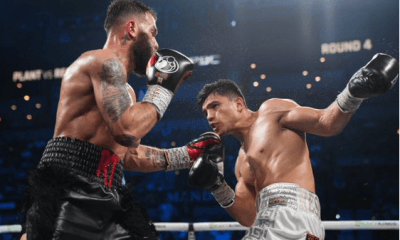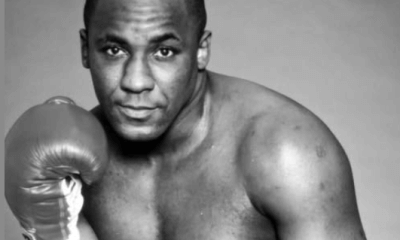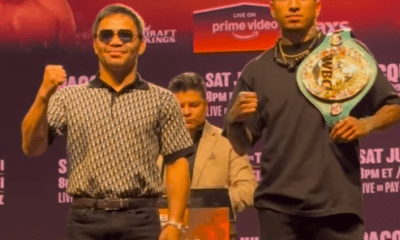Featured Articles
TERENCE CRAWFORD Is BWAA 2014 Fighter of the Year
Cameron Dunkin, the Boxing Writers Association of America’s Manager of the Year in 2007, is a true believer. When he puts his faith in one of his fighters, it’s absolute, and he will preach about his guy’s abilities with all the fervor of a tent-show revivalist. Sometimes that faith is misplaced and he comes away disappointed, but other times his instincts prove totally correct.
Early on in Terence “Bud” Crawford’s professional career, Dunkin admits to frustration in his attempts to sell something that none of the major promoters seemed to want. He was talking up a professional boxer from Nebraska? Hey, everybody knows that state is better known for producing bumper crops of very large linemen for the University of Nebraska football team than for little guys who can hook off the jab.
“Nobody wanted him,” Dunkin, the BWAA’s 2007 Manager of the Year, said of Crawford, the Omaha native whose fight for widespread acknowledgment was more daunting than his almost casual mastery of the opponents he was facing in the ring.
And now?
With three impressive victories in 2014, the 27-year-old Crawford (25-0, 17 KOs) is the winner of the Boxing Writers Association’s Sugar Ray Robinson Award as Fighter of the Year. He will be honored at the BWAA’s 90th annual Awards Ceremony on April 24 at a yet-to-be-determined venue in New York City, an event that will be emceed by Brooklyn Nets announcer David Diamante.
The remainder of the BWAA award winners will be announced Wednesday.
“It’s a surprise to me because that’s something that I never thought I’d be able to accomplish,” Crawford said when informed of his selection, in a close vote over WBO/IBF/WBA light heavyweight champion Sergey “Krusher”Kovalev. “Now that it’s happened, it almost feels like it’s not real.”
Dunkin’s persistent sales pitch finally was heard in the Top Rank organization, which isn’t surprising as several Dunkin-managed fighters (Crawford is co-managed by Brian McIntyre, who also serves as his trainer) have fought, and fought well, under the TR banner. Crawford signed a promotional contract with CEO Bob Arum’s star-making company shortly after he blasted out Derrick Campos in two rounds on July 30, 2011, to run his record to 13-0 with 10 victories inside the distance. But that bout was held at the Softball Country Arena in Denver, still too far off the radar screen to attract much attention.
That changed on March 30, 2013, at Las Vegas’ Mandalay Bay when Crawford dominated Breidis Prescott in taking a unanimous, 10-round decision, in the process winning 26 of the 30 total rounds on the three judges’ scorecards. He was definitely now on that figurative radar screen, including that monitored by his own promotional company. He was summoned back to Vegas around that time – he can’t recall the exact date – to be interviewed by Top Rank representatives and to pose for photographs, a sure sign that he was moving up from bit player to potential leading man.
“They asked me some questions,” Crawford said. “I said I felt that I had Omaha on my back, and they seemed to like that. I said I was going to take Omaha all the way to the top, and that’s what I did.”
Crawford launched his breakthrough year of 2014 in fine fashion, wresting the WBO 135-pound championship on a unanimous decision over gritty Scotsman Ricky Burns on March 1 in Glasgow, Scotland. That earned him, in a professional sense, a return ticket home – his only previous pro bout in Nebraska was on July 31, 2010, a one-round knockout of Anthony Mora in Grand Island – and he treated his growing legion of Omaha fans with HBO-televised, title-defending routs of 2004 Olympic gold medalist and former unified featherweight champion Yuriokis Gamboa (who was floored four times in losing by ninth-round TKO on June 28) and a wide unanimous decision over wily veteran Ray Beltran on Nov. 29. The thumping of Gamboa was a finalist for the BWAA’s Muhammad Ali/Joe Frazier Fight of the Year Award.
Perhaps just as significantly, the Gamboa and Beltran fights drew paid audiences of 10,943 and 11,127 in Omaha’s CenturyLink Arena, with the beatdown of Gamboa, a Miami-based Cuban, the first world title fight to be held in Nebraska’s largest city since heavyweight champ Joe Frazier carved up Ron Stander, the “Bluffs Butcher,” for a fifth-round TKO on May 25, 1972. Like Crawford said, he has Omaha on his back and he’s determined to take it to a lofty perch in boxing it hasn’t been often, if at all.
It will take more eye-opening victories like those, but Crawford just might have a chance to someday enter the ring of Omaha’s most cherished sports heroes, along with baseball Hall of Famer Bob Gibson, Heisman Trophy winner Johnny Rodgers and three-time first-team All-America basketball player Doug McDermott, who is from Ames, Iowa, but starred for four years at Omaha’s Creighton University.
“I’m looking for a big year again,” Crawford, who plans to move up in weight, said of his plans for 2015, beginning with his April 18 non-title date with Puerto Rican super lightweight Thomas Dulorme (22-1, 14 KOs), the site of which has yet to be announced but very likely will be Omaha. “I’m going to continue taking the biggest and best fights out there. I don’t want to take no step down. I want to prove I’m the best fighter in and around my division, and one of the best in any division. To be great, you got to set your sights on the Pacquiaos and the Mayweathers. Those are the kind of guys you got to fight, and beat.”
Although Crawford has his own style, it is in fact a hodgepodge of moves and strategies he has lifted from any number of great fighters he has admired since the time he took up boxing at the age of seven.
“I used to fall asleep watching tapes of old fights,” he said, citing Shane Mosley, Floyd Mayweather Jr., Felix Trinidad, Marco Antonio Barrera, Julio Cesar Chavez, Sugar Ray Leonard, Roberto Duran, Thomas Hearns and Ike Quartey as influences. “I’d try to take a little bit from this fighter, a little bit from that fighter.”
Not surprisingly, McIntyre has characterized Crawford as “a throwback fighter, from the ’70s or ’80s, just like Hagler, Hearns, Leonard and Duran. He will fight anyone, and duck nobody.”
Certainly, Beltran came away impressed by Omaha’s latest sporting favorite son. Every time he thought he was beginning to figure Crawford out, the champion would show him a different look.
“I’ve had six losses before him, but in my heart, as a man, I can really say this is the first guy that I feel had really beat me,” he said.
It is that ability to make in-round adjustments – he can go from orthodox to southpaw, and back again, as naturally as most people breathe in and out – that stamps Crawford as someone who could be a regular candidate for future Fighter of the Year awards.
“As a kid, that’s something my coaches always had me working on,” Crawford said. “They wanted me to be flexible, not one-dimensional like a lot of fighters are. We work on multiple things in the gym. Whenever I got something down pat, it was on to something else. And that was good, because I always want to learn. I try to soak up as much as I can.”
For Dunkin, Crawford’s arrival in the ranks of elite fighters is a happy occasion, on several levels. He said that Crawford not only is a tremendous talent, but an unspoiled, enthusiastic kid who is as good a person as he is a fighter.
“Both of them had great years,” he said of Crawford’s edging of Kovalev for the BWAA FOY Award. “Either one would have been a great choice, but I’m so glad my guy got it. I’m so happy for him. He’s worked so hard and never complains about anything. His attitude is always, `Let’s go. Let’s fight.’ You can really move a guy like that. He wants to fight, and he wants to be somebody.
“In a city like Omaha, which doesn’t have pro sports (other than a Triple-A baseball team), you just knew the time and place was ripe for somebody like him. He’s very popular, for all the right reasons. Not only can he really fight, but he’s such a great kid. I thought he would do well, but come on. To do as well as he has this fast … it’s just incredible.”
-

 Featured Articles4 weeks ago
Featured Articles4 weeks agoA Night of Mismatches Turns Topsy-Turvy at Mandalay Bay; Resendiz Shocks Plant
-

 Featured Articles2 weeks ago
Featured Articles2 weeks agoAvila Perspective, Chap. 330: Matchroom in New York plus the Latest on Canelo-Crawford
-

 Featured Articles1 week ago
Featured Articles1 week agoVito Mielnicki Jr Whitewashes Kamil Gardzielik Before the Home Folks in Newark
-

 Featured Articles4 weeks ago
Featured Articles4 weeks agoRemembering the Under-Appreciated “Body Snatcher” Mike McCallum, a Consummate Pro
-

 Featured Articles4 weeks ago
Featured Articles4 weeks agoAvila Perspective, Chap 329: Pacquiao is Back, Fabio in England and More
-

 Featured Articles3 weeks ago
Featured Articles3 weeks agoOpetaia and Nakatani Crush Overmatched Foes, Capping Off a Wild Boxing Weekend
-

 Featured Articles3 weeks ago
Featured Articles3 weeks agoFabio Wardley Comes from Behind to KO Justis Huni
-

 Featured Articles2 weeks ago
Featured Articles2 weeks agoCatching Up with Clay Moyle Who Talks About His Massive Collection of Boxing Books
















